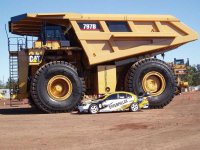ovrszd
Epic Contributor
- Joined
- May 27, 2006
- Messages
- 33,727
- Location
- Missouri
- Tractor
- Kubota M9540, Ford 3910FWD, Ford 555A, JD2210
You posted that "Cubic feet of air not pressure carries the load." Boyles law and the definition of pressure and volume contradict your statement. "The absolute pressure exerted by a given mass of an ideal gas is inversely proportional to the volume it occupies if the temperature and amount of gas remain unchanged within a closed system" By its definition it is the pressure exerted on the walls of the closed system that allows the pliable container to resist deformation. In this case your tire. The volume only describes the interior of the 3 dimensional space your tire contains. The volume of your tire will not change as long as you don't punch a hole in it. So if the volume is fixed, the only variable here that you can affect is the pressure. Occasionally mother nature will affect temp.
I think I understand your statement.
That Big A loaded with fertilizer will gross 27-30K on three tires. That's 9-10K per tire. Does it with 2-3 psi. Using your explanation, it is the pressure exerted on the walls of the closed system that allows the pliable container to resist deformation, how can that be?
No argument here. Just looking for clarity. I'm always open to learning.
